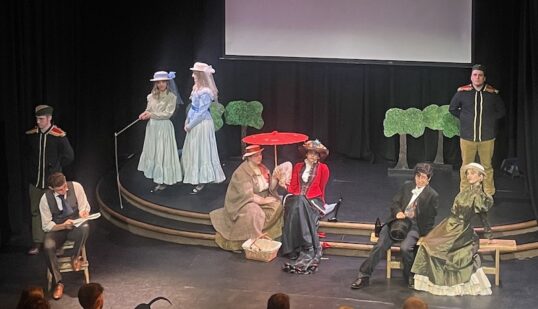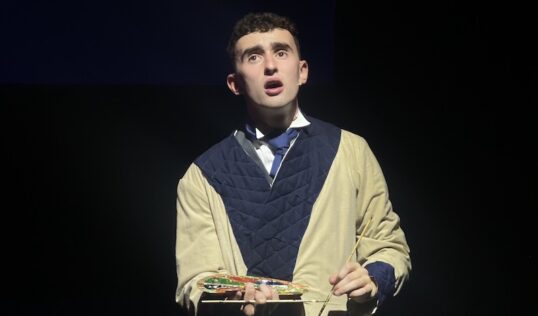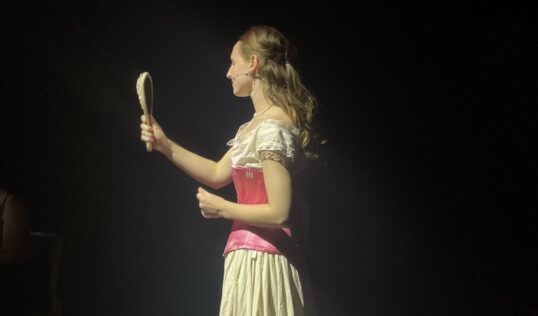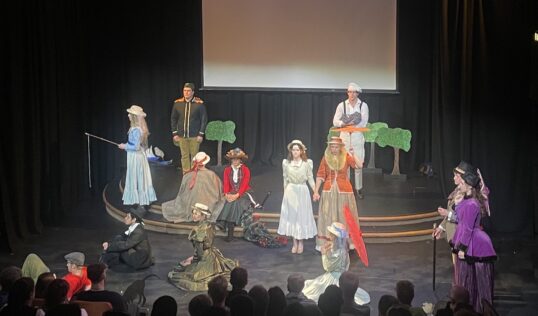Sunday in the Park with George
Paradise in Augustines (Venue 152): Mon 21 – Sat 26 Aug 2023
Review by Hugh Simpson
Edinburgh University Footlights’ production of Sunday in the Park with George, at Paradise in Augustines for the final week of the Fringe, is crafted with huge care and the maximum of good intentions.
However, an over-studied approach and a little too much technical ambition mean that it does not quite fulfil all of its potential.
Stephen Sondheim’s 1983 musical (with a book by James Lapine) is unusual in that it takes as its starting point a painting – the celebrated Sunday Afternoon on the Island of Grande Jatte by Georges Seurat. The first half of the work is a fictionalised portrayal of its painter, the 19th century French inventor of pointillism, and shows how the work came into being. Most of the second act deals with his (entirely fictional) descendant, a cynical American artist.
The death of Sondheim at the end of 2021 has led to people perhaps approaching his work with a little more reverence than they might have done when he was still around. Certainly this production treats the musical with conspicuous care – perhaps too much at times.
A student company might be expected at least to display an abundance of energy. Yet, while there is no shortage of skill on show, the polite admiration shown here lacks something in passion. It is true that much of the story is told by a series of tableaux, but there needs to be a bit more vigour sometimes.
The first performance starting late, and the second act being further delayed, did not help proceedings. This will surely tighten up over the run, but when you are already putting on a two-and-a-half-hour show, there is very little room for manoeuvre. As it stands, the pace – glacial at times – does become wearing.
old-fashioned
It all takes so long that the traditional nature of the narrative, somewhat at odds with the adventurous nature of the music, is only too apparent. While it is claimed here that Seurat applied the techniques of science to painting, eschewing Romantic ideas, there is something tiresomely old-fashioned about this portrait of a driven, obsessive, male (of course) genius, waiting for inspiration to strike. Not to mention the women who seem qualified only to provide that inspiration, and yet still unaccountably find him irresistible.
The second act, while certainly better integrated with the first than can be the case, provides no respite. Sondheim musicals at their best are fascinating, challenging and rewarding, but sometimes they can seem clever-clever and remarkably annoying. Here, the songs seem dragged out and on occasion – despite the efforts of the singers – almost listless.
Technical problems extended to that perennial trouble with mic-switching; when the first couple of words are a song are missed, it hardly matters, but when it’s a one-word answer that is supposed to help give the key to knitting the whole plot together, it is more serious.
talent
This does not hugely affect the singing, however, and there is certainly a great deal of talent on display. The chorus numbers have a wonderfully detached air and staccato clarity, and the individual singers impress.
George Seurat (perhaps English-speaking audiences couldn’t be counted on to understand a name with an ‘s’ on the end) and his descendant, also George, are performed with intensity by Chris Kane, whose dramatic range and melodicism shine through.
Phoebe Simpson who plays original painter’s model, Dot, and the later artist’s grandmother, Marie, is tremendous at acting through song. She is also unusually good for a younger performer at playing someone aged nearly 100 and sounding suitably old without stereotyping. Giulia Pesciarelli also plays an older character with sympathy and tunefulness.
Sebastian Schneeberger and Alice Wollocombe portray Jules, a fellow painter, and his wife Yvonne with a combination of snootiness and underlying empathy, while Catherine McStay & Ottilie Hill Smith have life and humour as two young women both called Celeste. Sally Franks and Felix Foote shine in more comic roles.
The cast also double up in the modern story; these roles are equally well done. Indeed, the whole ensemble are well drilled throughout. Perhaps too much so, as even the more modern scenes, supposed to be set in the buzzy 1980s art world, have a posed element to them that approaches dryness.
precision
There is nothing really wrong with the direction of Harriet Masters and Tom Steed; their only fault is trying too hard not to make mistakes, when a little more roughness around the edges would have actually made for a pacier, more convincing show. Similarly, there is a precision and exactness to MD Rebecca Kelly and her 10-piece band that is praiseworthy, but leads to just a smidgeon too much stateliness.
Zofia Klim and Ryan Dai’s costume designs are excellent, while there is an understandably strong visual element to Louis Eggeling’s set design. The technical elements of the visuals do not always come off; perhaps the effects of 1980s George’s ‘chromolume’ (which ironically has to fail itself in the play) are best left largely to the audience’s imagination.
Much like the central figure in this invented version of Seurat’s life, this ends up being remarkably easy to admire, but not quite so easy to hold in any great or lasting affection.
Running time: two hours 35 minutes (including one interval)
Paradise in Augustines (The Sanctuary), 41 George IV Bridge, EH1 1EL (Venue 152)
Monday 21 – Saturday 26 August 2023
Daily at 11.55 am
Tickets and details Book here. https://tickets.edfringe.com/whats-on/sunday-in-the-park-with-george
Edinburgh University Footlights links:
Facebook: @edfootlights
Instagram: @eufootlights
ENDS
#MadeInEdinburgh






















